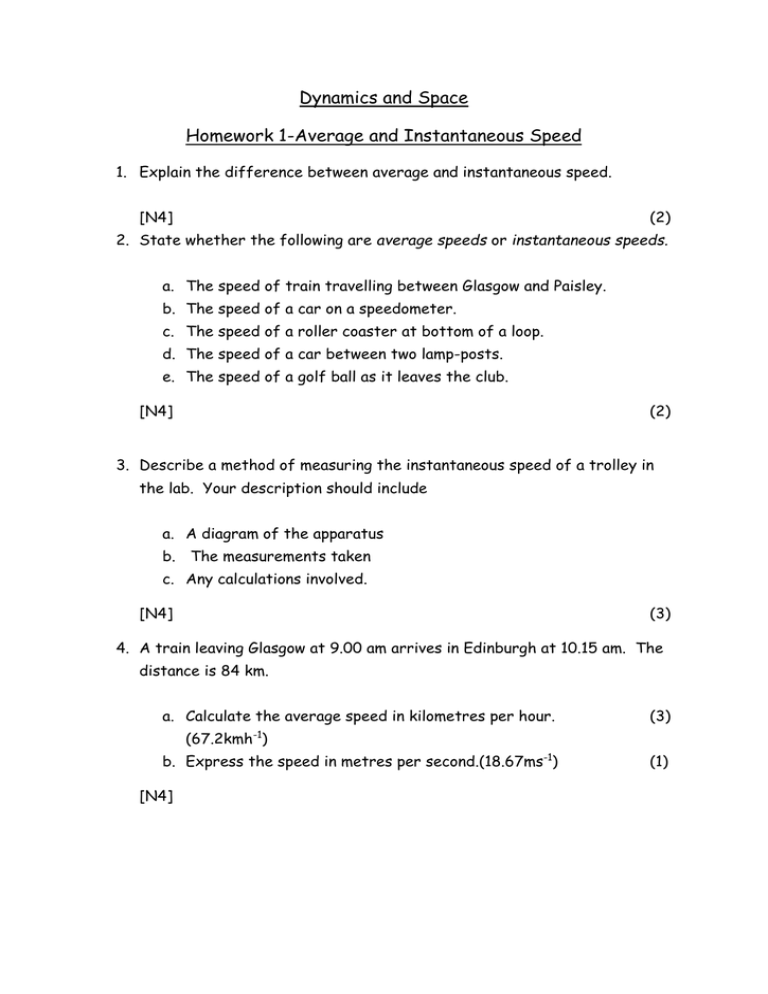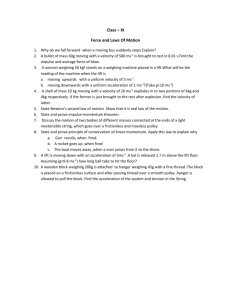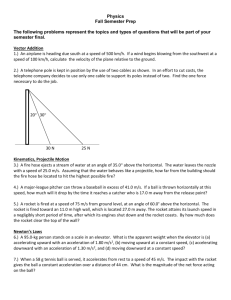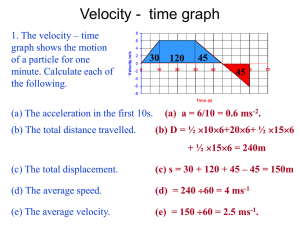Dynamics and Space Nat 5 homework+numerical answers
advertisement

Dynamics and Space Homework 1-Average and Instantaneous Speed 1. Explain the difference between average and instantaneous speed. [N4] (2) 2. State whether the following are average speeds or instantaneous speeds. a. The speed of train travelling between Glasgow and Paisley. b. The speed of a car on a speedometer. c. The speed of a roller coaster at bottom of a loop. d. The speed of a car between two lamp-posts. e. The speed of a golf ball as it leaves the club. [N4] (2) 3. Describe a method of measuring the instantaneous speed of a trolley in the lab. Your description should include a. A diagram of the apparatus b. The measurements taken c. Any calculations involved. [N4] (3) 4. A train leaving Glasgow at 9.00 am arrives in Edinburgh at 10.15 am. The distance is 84 km. a. Calculate the average speed in kilometres per hour. (3) (67.2kmh-1) b. Express the speed in metres per second.(18.67ms-1) [N4] (1) 5. A jet travels from London to New York at an average speed of 223 ms-1. The flight time is 7 hours. Calculate the distance travelled by the jet. (5.6 x 106 m) [N4] (3) 6. A student carries out an experiment to measure the instantaneous speed of a trolley using the apparatus shown below. timer photocell light source 0.15 s trolley The length of the trolley is 30 cm. The time recorded on the timer is 0.15 s. Use the measurements to calculate the instantaneous speed of the trolley. (2ms-1) [N4] (3) Dynamics and Space Homework 2-Scalars and Vectors 1. A cyclist travels along a straight road at 7ms-1. Calculate how long it takes her to travel 1 mile? (228.6s) (hint; you will need to find out how many metres = 1mile) [N4] (3) 2. Physical quantities can be categorised as either scalar or vector. a. Describe what is meant by a scalar quantity. (1) b. Describe what is meant by a vector quantity. (1) [N5] 3. Sort the following into a table with the headings scalar quantity and vector quantity. force distance displacement velocity speed [N5] time (2) 4. During a race, a car makes 25 complete laps of a course of 5 km. (a) What is the total distance travelled by the car after 25 complete laps? (125km) [N4] (b) (1) What is the resultant displacement of the car after 25 complete laps? (0km) [N5] (1) 5. An athlete runs 8 km due west then turns and runs 6 km due north as shown in the diagram. 000˚ 270˚ 090˚ FINISH 180˚ 6 km 8 km START a. What is the total distance that the athlete travelled? [N4] (14km) (1) b. By scale diagram or otherwise, find the resultant displacement of the athlete. [N5] (10km@36.90 N of W or 3070) (3) c. The run was completed in 75 minutes. i. Calculate the average speed of the athlete in ms-1. [N4] (3.11ms-1) (3) ii. Calculate the average velocity of the athlete in ms-1. [N5] (2.22ms-1@36.90 N of W or 3070) (3) 6. A person walks 3km due South followed by 2km due West and then 1km due North. If the total time for the walk was 90 minutes then calculate: (a) The total distance travelled. [N4] (6km) (b) The average speed [N4] (1.1ms-1) (c) (3) The displacement. [N5] (2.82km (or 2820m) @ 45o W of S or 135o) (d) (1) (3) The average velocity of the person. [N5] (0.52 ms-1 @ 45o W of S or 135o) (3) Dynamics and Space Homework 3-Acceleration and Velocity/Time Graphs (1) 1. State the definition of acceleration. [N4] (1) 2. A Ford Fiesta increases its velocity from 2 ms-1 to 16 ms-1 in 10s. A Peugeot 207 takes 8s to accelerate to 11 ms-1 from rest. Show by calculation which car has the greater acceleration. [N4] (1.4 ms-2, 3.7 ms-2) (3) 3. A car slows from 70 mph to 30 mph in 5 s when taking the exit from a motorway. (a) Calculate the deceleration in mphs-1. [N4] (b) (8mphs-1) (3) If 1 mile = 1.6 km, what is the deceleration in kmh-1s-1? [N4] (c) (12.8kmhs-1) (3) Calculate the deceleration in ms-2. [N4] (3.6ms-2) (1) 4. The motion of a race car is recorded as follows: Time (s) Speed (m/s) 0 10 20 30 40 50 60 70 80 5 5 20 35 50 50 50 25 0 (a) Using the graph paper provided, draw a speed time graph of the race car’s journey. [N5] (b) (4) Using the graph you have drawn, describe the motion of the race car over the 80 seconds. [N5] (c) (2) Using the graph you have drawn, calculate i. The acceleration between 10 and 40 s. (3) (0.83 ms-2) ii. The total distance travelled by the race car. (3) (2262.5m) iii. The average speed during the 80 seconds. [N5] (28.3ms-1) (3) Dynamics and Space Homework 4-Acceleration and Velocity/Time Graphs (2) 1. During a game of ten-pin bowling, a player gives bowling ball an acceleration of 3 ms-2 for 1.2 s. Assuming the bowling ball was accelerated from rest, calculate the final velocity of the bowling ball. (3.6ms-1) [N4] (3) 2. A supertanker travelling at 13 ms-1 decelerates at a rate of 0.03 ms-2. How long does it take to come to a complete stop? (433.3s) [N5] (3) 3. A rocket accelerates at 5.2 ms-2 for 10 minutes to reach a final velocity of 6200 ms-1. Calculate the initial velocity of the rocket. (3080 ms-1) [N5] (3) 4. The velocity-time graph shown below describes the motion of a ball which has been thrown straight up into the air then allowed to fall to the ground. 15 10 Velocity(ms-1) 5 0 Series1 0 0.5 1 1.5 2 2.5 -5 -10 -15 Time(s) (a) At what time does the ball reach its maximum height? [N5] (b) (1) Calculate the maximum height that the ball reaches. [N5] (5m) (3) Dynamics and Space Homework 5-Weight, Mass and Gravitational Field Strength 1. Give 2 reasons why a spring is used in a Newton balance. [N4] (2) 2. A student takes two identical pieces of paper. She crumples one into a ball and leaves the other one as a flat sheet. The student then drops both pieces of paper. Which piece of paper will land first? Explain your answer. [N4] (2) 3. Mass and weight mean different things. (a) Explain what is meant by mass. [N4] (b) (1) What are the SI units of mass? [N4] (c) (1) Explain what is meant by weight. [N4] (d) (1) What are the SI units of weight? [N4] (1) 4. Define the term gravitational field strength. [N4] (1) 5. Molly has a mass of 48 kg on Earth (g = 9.8 Nkg-1) (a) Calculate her weight on i) Earth and (3) [N4] (470.4N) ii) the moon where g = 1.6 Nkg-1 [N4] (76.8N) (3) (b) What is her mass on the moon. [N4] (1) 6. Jack is doing the shopping for his granny and fills the trolley with food so that it weighs 650N (on Earth). (a) [N4] (b) Calculate the mass of the trolley. (66.3kg) (3) A 2.5 kg Melon rolls off the trolley. What is the new weight of the trolley? [N4] (625.24N) (4) 7. The drawings show objects free-falling near the surface of various planets. For each, calculate the gravitational field strength of the planet. Jupiter Earth Mars 20kg Saturn 3kg 5kg 7kg W=520N W=26N W=49N W=34N (26Nkg-1 , 3.7Nkg-1, 9.8NKg-1 , 11.3Nkg-1) [N4] (4) Dynamics and Space Homework 6-Friction and Newton’s 1st Law 1. Look at the cyclists in the picture below. (a) Identify three ways in which friction acting against the bicycles or cyclists has been reduced. [N4] (2) (b) On other occasions, it is useful to increase the amount of friction acting. i. Identify two places on a bicycle where it friction is increased. [N4] ii. (1) For each place, explain why friction should be increased. [N4] (2) (c) The cyclists find that as they start off, they can accelerate easily. After a while though, they have to pedal hard just to maintain a constant speed. Explain why this happens. [N5] (2) 2. Copy and complete the following: An object will remain at _ _ _ _ or continue to travel at a _ _ _ _ _ _ _ _ speed in a straight line, unless an _ _ _ _ _ _ _ _ _ _ force acts. Therefore if the forces acting on the object are _ _ _ _ _ _ _ _ then the object will either be _ _ _ _ _ _ _ _ _ _ or will be moving at a _ _ _ _ _ _ _ _ speed. [N5] (2) 3. A weightlifter holds a bar as shown. The mass of the bar is 180 kg. (a) Calculate the weight of the bar. [N4] (1764N) (3) (b) What size of force did the weightlifter apply to raise the bar at a constant speed? [N5] (1) (c) What is the size of force that the weightlifter applies to hold the bar stationary? [N5] (1) Dynamics and Space Homework 7-Resultant Force and Newton’s 2nd Law 1. A rocket engine produces a thrust of 20 kN on a mass of 500 kg travelling along a track. If the air resistance is negligible then calculate the acceleration of the rocket engine. [N4] (30.2ms-2) (3) 2. A fully laden oil tanker of mass 6.5x107 kg sets off from its port on a bearing of 090°. Its engine produces a force of 4.0x106 N. A tugboat pushes against the tanker as shown with a force of 3.0x106N. ( 5 x 106N @ 370 N of E or 0530) 000˚ 4.0x106 N TANKER 270˚ 090˚ engine force 180˚ force from tugboat 3.0x106 N (a) Using a scale diagram or otherwise, find the resultant force acting on the tanker. [N5] ( 5 x 106N @ 370 N of E or 0530) (b) (3) Calculate the initial acceleration of the tanker. [N4] (0.08ms-2) (3) 3. A car of mass 1500 kg accelerates at a rate of 2.3 ms-2. The engine of the car provides a force of 4000 N. Calculate the size of the frictional force acting on the car. [N5] (550N) (3) 4. A firework of mass 0.2 kg provides an initial upwards thrust of 2.8 N. (a) Calculate the weight of the firework. [N4] (1.96N) (3) (b) Draw a diagram and label the forces acting on the firework. [N5] (c) Calculate the unbalanced force acting on the rocket [N5] (0.84N) (d) (3) Calculate the initial acceleration of the firework. [N5] (4.2ms-2) (e) (3) (3) As the firework ascends, its acceleration increases. Explain why the acceleration increases. [N5] 5. A lifting machine applies an upward force of 92 N to lift a 20 kg box of rocks on the Moon where ‘g’ = 1.6 N/kg. Calculate the size and direction of the unbalanced force exerted on the box and its acceleration. [N5] (60N , 3ms-2) (2) (5) Dynamics and Space Homework 8-Newton’s 3rd Law,Free-fall & Accln due to Gravity Speed (m/s) 1. The speed-time graph for a sky-dive is shown below: (a) Explain why the gradient of the graph is decreasing between 0 and 20 seconds. [N5] (2) (b) At what time is the parachute opened? [N5] (1) (c) What is the name given to the constant velocity reached during free-fall? [N5] (1) 2. Josie and Kirsty are arguing about how a water rocket lifts off. Josie Kirsty Jim Jim knows that what Josie says isn’t true, but Kirsty has not provided a an actual explanation either. Dave reminds Kirsty about Newton’s Third Law and they both go back and offer an explanation to Josie. Copy and complete what they say to Josie. “OK Josie, this is to do with Newton’s Third Law, action and forces. The rocket pushes the water the pushes the rocket sized force. It has nothing to do with the , and as a reaction, with an pushing on the ground.” [N5] (2) 3. Show how gravitational field strength and acceleration due to gravity are equivalent. (Refer to your notes if you are unsure!) [N5] (2) 4. A student drops a football from above her head. It lands on the ground 0.63 seconds after being dropped. Calculate the velocity of the ball at the instant it strikes the ground. Assume that air resistance is negligible. [N5] (6.2ms-1) (3) 5. An astronaut drops a hammer on the Moon where the gravitational field strength is 1.6 Nkg-1. The hammer lands on the surface of the Moon 2.1 seconds after being dropped. (a) Show that the hammer strikes the surface of the Moon with a velocity of 3.36 ms-1. [N5] (b) Draw a velocity-time graph for the hammer as it falls. [N5] (c) (3) (2) Use the graph to calculate the height that the hammer was dropped from. [N5] (3.5m) (3) Dynamics and Space Homework 9 – Work Done and Power 1. How much work is done by a 20 N force which moves an object for a total distance of 50 metres in the direction of the force? [N4] (1000J) (3) 2. A boy does 72 J of work in dragging a 30 kg mass along a floor for 3 metres. What force does he apply? (Assume the force is parallel to the floor.) [N4] (24N) (3) 3. A caravan needs a towing force of 400 N at 30 m.p.h. How much work would a car engine need to do to tow the caravan at this speed along a level stretch of road for 5 km? [N4] (2 x 106J) (4) 4. Calculate how much potential energy you gain when you climb a vertical height of 10 m. Where does the energy to climb the stairs come from? (If you don’t have scales to record your mass, make it up. It’s the only time you’ll get to do it!) [N4] (3) 5. A 2kg mass has 50 J of potential energy . What height is it at? [N5] (2.6m) (3) 6. A student at the top of a roller coaster ride, 50 m high has 30 000 J of potential energy . Calculate the mass of the student. [N5] (61.2kg) (3) 7. A crane does 5 000 J of work in 10 s. Calculate its power output. [N4] (500W) (3) 8. A lift motor exerts a constant force of 25 000 N in moving the lift through a height of 15 m. The operation takes 20s. Calculate : (a) the speed of the lift. [N4] (0.75ms-1) (b) the work the lift motor does against gravitational force [N4] (3.75 x 105N or 375kN) (c) (3) (3) the power output of the motor [N5] (18750W) (3) 9. Calculate how long a 5 000 W motor would take to lift a roller coaster car of mass 250 kg through a height of 50 m. [N5] (24.5s) (3) Dynamics and Space Homework 10 - Conservation of Energy 1. A bus of mass 7 500 kg is travelling at 20 m s-1. (a) Calculate its kinetic energy. [N4] (1.5 x 106J) (b) If 10 passengers of average mass 65 kg get on the bus calculate its new kinetic energy if its speed remains unchanged. [N4] (1.3 x 105J) (3) (3) 2. A spaceship is travelling at 5 km s-1 far away from any planet. The rocket has 1.25 x 1011 J of kinetic energy. (a) Calculate the mass of the spaceship. [N5] (1.0 x 104kg) (b) (3) The astronauts wish to slow the rocket down too 1 km s-1. Calculate the kinetic energy of the spaceship at this new speed. [N5] (5.0 x 109J) (c) Calculate the work done slowing the spaceship down by the rocket engine [N5] (1.2 x 1011J) (d) (3) (3) Calculate the time the 6.0 x109 W engine is fired for. [N5] (20s) (3) mass of ball = 1.2kg 3. 15m 5m At the bottom of the slope it is discovered that the ball has 50 J of ‘kinetic’ energy. Calculate a) the potential energy of the ball at the top of the slope [N4] (58.8J) (3) b) the work done against friction [N5] (8.8J) (3) c) the average frictional force acting. [N5] (0.59N) (3) 4. A 2 kg trolley,with very light wheels,moving along a horizontal surface at 5 ms-1, runs up an increasingly steep slope and stops at a certain height. 5 m/s 2 kg (a) Assuming that it rolls without loss of energy due to friction, calculate how high it reaches up the slope. [N5] (1.3m) (3) (b) If the trolley did lose some energy because of friction, how would you expect the height reached to compare with your answer to (a)? Why? [N5] (2) Dynamics and Space Homework 11 - Projectiles and Satellites 1. A javelin is launched horizontally at 5 ms-1. It lands 15 metres horizontally from its launch point. 5 m/s 15 metres (a) [N4] (b) [N5] (c) Calculate the time that the javelin is in the air for. (3s) (3) Calculate the final vertical velocity of the javelin (29.4ms-1) (3) Using a scale diagram or otherwise, find the size of the final resultant velocity of the javelin. [N5] (29.8ms-1@450 S of E or 1350) (3) 2. A ball rolls off a table top with a horizontal speed of 2.0 ms-1. The ball hits the ground 0.3 seconds later. (a) Calculate the horizontal distance that the ball lands from the table top. [N4] (b) [N5] (0.6m) (3) Calculate the final vertical speed of the ball. (2.94ms-1) (3) (c) Sketch a velocity-time graph of the vertical motion of the ball. [N5] (d) (3) Use the graph to find the height of the table [N5] (0.4m) (3) 3. Explain how an artificial satellite such as the International Space Station remains in orbit around the Earth. [N4] (2) 4. Curved reflectors are used to increase the strength of a received signal from a satellite. (a) Copy and complete the diagram to show how the transmitted signal is collected by the receiving aerial. transmitting aerial receiving aerial curved reflector curved reflector [N4] (b) (2) Why is a dish with a large diameter more effective than a smaller one? [N4] (2) 5. Describe 3 applications of satellites. [N4] (2) Dynamics and Space Homework 12 – Space Exploration 1. We now have evidence to support the Big Bang Theory. (a) State two pieces of evidence that scientists have provided that support the Big Bang Theory. [N4] (b) (2) Provide a description of how each piece of evidence supports ideas in the Big Bang Theory. [N4] (2) 2. Various Technologies that were originally developed in space exploration programmes has proved to be useful in everyday life. (a) Write down one technology that was originally developed for a space programme that is now used in everyday life. [N4] (b) (2) Describe briefly how the technology benefits society. [N4] (2) 3. During re-entry to the Earth’s atmosphere, a spacecraft will undergo a considerable increase in temperature. (a) What causes this increase in temperature? [N4] (1) (b) In spacecraft design, particular attention must be paid to the features of the heat shield material used. From the list below, select two features of a heat shield that will help to protect the spacecraft. Low specific heat capacity High specific heat capacity Black in colour White in colour Thick Thin Large surface area Small surface area [N4] (c) (1) For each feature that you chose, explain how it protects the spacecraft [N4] (2) 4. At launch, a rocket of mass 20 000 kg accelerates off the ground at 12 ms-2 (ignore air resistance) (a) Use Newton’s 3rd law of motion to explain how the rocket gets off the ground. [N5] (2) (b) Draw a free body diagram to show all the vertical forces acting on the rocket as it accelerates upwards. [N5] (3) (c) Calculate the engine thrust of the rocket which causes the acceleration of 12ms-2. [N5] (4.4 x 105N) (3) (d) The same rocket reaches a speed of 10 000 ms-1 as it accelerates away from earth. Can you suggest 3 reasons why the acceleration of the rocket will increase? (Hint: this time take into consideration air resistance) [N5] (2) Dynamics and Space Homework 13 – Cosmology 1. An astronomer views the following objects in the night sky: Jupiter, which orbits the Sun; Europa, which orbits Jupiter; the Andreomeda Galaxy. (a) Which of the objects mentioned is a moon? [N4] (b) Which of the objects mentioned is a planet? [N4] (c) (1) (1) Which of the objects mentioned is a star? [N4] (1) 2. Cosmologists use “light years” as a unit of distance. (a) Calculate the number of metres in 1 light year. [N5] (9.5 x 1015 m) (b) (3) The Leo A Galaxy is 2.25 million light years from the Earth. Calculate this distance in metres. [N5] (2.1 x 1022m) (3) 3. White light is part of the electromagnetic spectrum – a family of radiation waves with different wavelengths. (a) List all of the members of the electromagnetic spectrum, from shortest wavelength to longest wavelength. [N4] (2) (b) What property do all of the members have in common? [N4] (c) (1) White light can be split into different colours. X Y Z What is the name of the glass block shown that splits the white light into different colours? [N4] (d) (1) Name another piece of equipment that can be used to split light into different colours. [N4] (e) (1) Which of the colours blue, green and red are seen at each position X, Y and Z? [N4] (f) (1) The same device can be used to analyse light from a star. What information can be obtained from this analysis? [N5] (1) 4. Explain, using the term ‘Line spectra’ how astronomers identify elements present in distant stars. [N5] (2)






